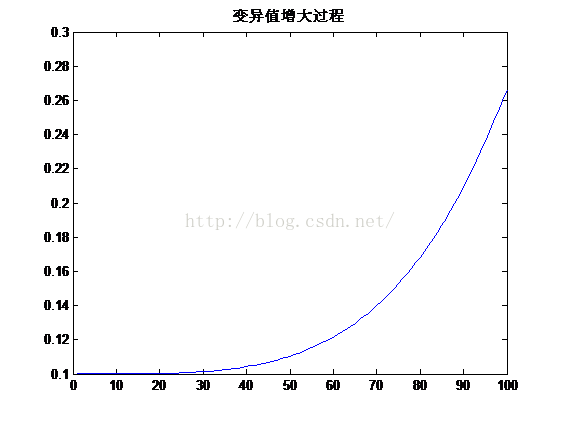遗传算法的基本原理和matlab实现
2016年9月7日星期三
T.s.road 总结笔记
遗传算法解决全局优化(即为最值点如图中C,D),而局部最优解决的是极值点问题(如图中A,B)
1. 遗传算法流程;
%遗传算法的伪代码描述:
%Procedure GA
%Begin
% T=0;
% Initialize p(t) ; //p(t)表示 t代种群
% Evaluate p(t); //评估第t代种群
% While not finished do
% Begin
% T=t+1;
% Select p(t) from p(t-1); //从上代种群众选择较优秀的个体到下代子群
% Reproduce pairs in p(t);
% Evaluate p(t);
% End
%End
| 生物 |
算法 |
| 物竞天择 |
选择、交叉、变异 |
| 适者生存 |
适应度 |
故遗传算法主要过程及流程图如下
1)编码(适应度函数,产生初始种群)
2)遗传算子(选择、交叉、变异)
3)繁衍种群
2. 参数初始化,编码阶段
假设目标函数为
a. 定义个体基因,基因是遗传密码,这里自变量就是基因所携带的信息,即用2进制来表示自变量的可能取值。基因序列的长度由自变量取值范围确定。
b. 定义适应度函数,目标函数是,适应度函数就定义为。
c. 由a,b可知,我们定义好了个体(基因)与适应度函数,现初始化种群,定义种群大小,及繁衍代数。
(1)M:种群规模
(2)T:遗传运算的终止进化代数
(3)Pc:交叉概率
(4)Pm:变异概率
%% @authors Keung Charteris & T.s.road CZQ
% @version 1.0 ($Revision$)
% @date 7/9/2016 $LastChangedDate$
% @addr. GUET, Gui Lin, 540001, P.R.China
% @contact : [email protected]
% @date Copyright(c) 2016-2020, All rights reserved.
% This is an open access code distributed under theCreative Commons Attribution License, which permits
% unrestricted use, distribution, and reproduction in anymedium, provided the original work is properly cited.
functionTestGA0904()
clc; %清除所有
clear all;%清除变量
close all;%关闭图片
format long
% step 1 编写目标函数
FUN =@(x) (x)^2+81*sin(x);
% step 2 生成初始种群,大小为100
initPop={[0, 9],100,10};
[BestPop,Trace]=fga(FUN,initPop{1,1}(1),initPop{1,1}(2),initPop{1,2},initPop{1,3});
3. 遗传算子
遗传算法使用选择运算来实现对群体中的个体进行优胜劣汰操作:适应度高的个体被遗传到下一代群体中的概率大;适应度低的个体,被遗传到下一代群体中的概率小。选择操作的任务就是按某种方法从父代群体中选取一些个体,遗传到下一代群体。
a. 轮盘赌选择又称比例选择算子,它的基本思想是:各个个体被选中的概率与其适应度函数值大小成正比。设群体大小为n,个体i 的适应度为 Fi,则个体i 被选中遗传到下一代群体的概率为:
%% @authorsKeung Charteris & T.s.road CZQ
% @version1.0 ($Revision$)
% @date6/9/2016 $LastChangedDate$
% @addr.GUET, Gui Lin, 540001, P.R.China
% @contact :[email protected]
% @dateCopyright(c) 2016-2020, All rights reserved.
% This is anopen access code distributed under the Creative Commons Attribution License,which permits
%unrestricted use, distribution, and reproduction in any medium, provided theoriginal work is properly cited.
%选择操作
%采用基于轮盘赌法的非线性排名选择
%各个体成员按适应值从大到小分配选择概率:
%P(i)=(q/1-(1-q)^n)*(1-q)^i, 其中 P(0)>P(1)>...>P(n), sum(P(i))=1
function [selectpop]=NonlinearRankSelect(FUN,pop,bounds,bits)
global m n
selectpop=zeros(m,n);
fit=zeros(m,1);
for i=1:m
fit(i)=feval(FUN(1,:),(b2f(pop(i,:),bounds,bits)));%以函数值为适应值做排名依据
end
selectprob=fit/sum(fit);%计算各个体相对适应度(0,1)
q=max(selectprob);%选择最优的概率
x=zeros(m,2);
x(:,1)=[m:-1:1]';
[yx(:,2)]=sort(selectprob);
r=q/(1-(1-q)^m);%标准分布基值
newfit(x(:,2))=r*(1-q).^(x(:,1)-1);%生成选择概率
newfit=cumsum(newfit);%计算各选择概率之和
rNums=sort(rand(m,1));
fitIn=1;newIn=1;
while newIn<=m
ifrNums(newIn)b. 交叉运算,是指对两个相互配对的染色体依据交叉概率 Pc 按某种方式相互交换其部分基因,从而形成两个新的个体。交叉运算是遗传算法区别于其他进化算法的重要特征,它在遗传算法中起关键作用,是产生新个体的主要方法。 SGA中交叉算子采用单点交叉算子。
| 交叉前 |
交叉后 |
| 00000|01110000000010000 11100|00000111111000101 |
00000|00000111111000101 11100|01110000000010000 |
%% @authorsKeung Charteris & T.s.road CZQ
% @version1.0 ($Revision$)
% @date6/9/2016 $LastChangedDate$
% @addr.GUET, Gui Lin, 540001, P.R.China
% @contact :[email protected]
% @dateCopyright(c) 2016-2020, All rights reserved.
% This is anopen access code distributed under the Creative Commons Attribution License,which permits
%unrestricted use, distribution, and reproduction in any medium, provided theoriginal work is properly cited.
%交叉操作
function [NewPop]=CrossOver(OldPop,pCross,opts)
%OldPop为父代种群,pcross为交叉概率
global m NewPop
r=rand(1,m);
y1=find(r=pCross);
len=length(y1);
if len>2&&mod(len,2)==1%如果用来进行交叉的染色体的条数为奇数,将其调整为偶数
y2(length(y2)+1)=y1(len);
y1(len)=[];
end
if length(y1)>=2
for i=0:2:length(y1)-2
ifopts==0
[NewPop(y1(i+1),:),NewPop(y1(i+2),:)]=EqualCrossOver(OldPop(y1(i+1),:),OldPop(y1(i+2),:));
else
[NewPop(y1(i+1),:),NewPop(y1(i+2),:)]=MultiPointCross(OldPop(y1(i+1),:),OldPop(y1(i+2),:));
end
end
end
NewPop(y2,:)=OldPop(y2,:);
c. 所谓变异运算,是指依据变异概率 Pm 将个体编码串中的某些基因值用其它基因值来替换,从而形成一个新的个体。遗传算法中的变异运算是产生新个体的辅助方法,它决定了遗传算法的局部搜索能力,同时保持种群的多样性。交叉运算和变异运算的相互配合,共同完成对搜索空间的全局搜索和局部搜索。 SGA中变异算子采用基本位变异算子。
| 变异前 |
变异后 |
| 000001110000000010000 |
000001110001000010000 |
%% @authorsKeung Charteris & T.s.road CZQ
% @version1.0 ($Revision$)
% @date6/9/2016 $LastChangedDate$
% @addr.GUET, Gui Lin, 540001, P.R.China
% @contact :[email protected]
% @dateCopyright(c) 2016-2020, All rights reserved.
% This is anopen access code distributed under the Creative Commons Attribution License,which permits
%unrestricted use, distribution, and reproduction in any medium, provided theoriginal work is properly cited.
%变异操作
function [NewPop]=Mutation(OldPop,pMutation,VarNum)
global m n NewPop
r=rand(1,m);
position=find(r<=pMutation);
len=length(position);
if len>=1
fori=1:len
k=unidrnd(n,1,VarNum); %设置变异点数,一般设置1点
forj=1:length(k)
ifOldPop(position(i),k(j))==1
OldPop(position(i),k(j))=0;
else
OldPop(position(i),k(j))=1;
end
end
end
end
NewPop=OldPop;
结果如下:





